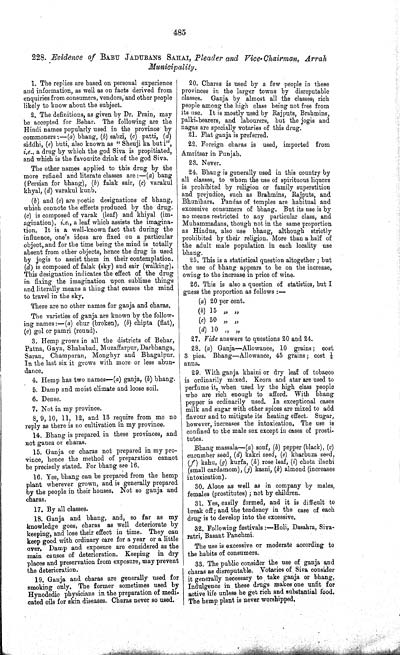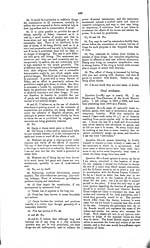Medicine - Drugs > Report of the Indian Hemp Drugs Commission, 1894-1895 > Volume IV
(499) Volume 4, Page 485
Thumbnail gallery: Grid view | List view

485
228. Evidence of
BABU JADUBANS SSHAI, Pleader and Vice-Chairman,
Arrah
Municipality.
1. The replies are
based on personal experience
and information, as well as on facts derived from
enquiries from consumers, vendors, and other people
likely to know about the subject.
2. The definitions,
as given by Dr. Prain, may
be accepted for Behar. The following are the
Hindi names popularly used in the province by
commoners:—(a) bhang, (b) sabzi, (c) patti,
(d)
siddhi, (e) buti, also known as "Sheuji ka
but i",
i.e., a drug by which the god Siva is propitiated,
and which is the favourite drink of the god Siva.
The other names applied
to this drug by the
more refined and literate classes are: —(a) bang
(Persian for bhang), (b) falak sair, (c)
varakul
khyal, (d) varakul kunb.
(b) and (c)
are poetic designations of bhang,
which connote the effects produced by the drug.
(c) is composed of varak (leaf) and khiyal (im-
agination), i.e., a leaf which assists the imagina-
tion. It is a well-known fact that during the
influence, one's ideas are fixed on a particular
object, and for the time being the mind is totally
absent from other objects, hence the drug is used
by jogis to assist them in their contemplation.
(d) is composed of falak (sky) and sair (walking).
This designation indicates the effect of the drug
in fixing the imagination upon sublime things
and literally means a thing that causes the mind
to travel in the sky.
There are no other names for ganja and charas.
The varieties of ganja
are known by the follow-
ing names:—(a) chur (broken), (b) chipta
(flat),
(c) gol or pamri (round).
3. Hemp grows
in all the districts of Behar,
Patna, Gaya, Shahabad, Muzaffarpur, Darbhanga,
Saran, Champaran, Monghyr and Bhagalpur.
In the last six it grows with more or less abun-
dance.
4. Hemp has two names—(a) ganja, (b) bhang.
5. Damp and moist climate and loose soil.
6. Dense.
7. Not in my province.
8, 9, 10, 11, 12,
and 13 require from me no
reply as there is no cultivation in my province.
14. Bhang is
prepared in these provinces, and
not ganea or charas.
15. Ganja or charas
not prepared in my pro-
vince, hence the method of preparation cannot
be precisely stated. For bhang see 16.
16. Yes, bhang can
be prepared from the hemp
plant wherever grown, and is generally prepared
by the people in their houses. Not so ganja and
charas.
17. By all classes.
18. Ganja and
bhang, and, so far as my
knowledge goes, charas as well deteriorate by
keeping, and lose their effect in time. They can
keep good with ordinary care for a year or a little
over. Damp and exposure are considered as the
main causes of deterioration. Keeping in dry
places and preservation from exposure, may prevent
the deterioration.
19. Ganja and
charas are generally used for
smoking only. The former sometimes used by
Hynodedic physicians in the preparation of medi-
cated oils for skin diseases. Charas never so used.
20. Charas is used
by a few people in these
provinces in the larger towns by disreputable
classes. Ganja by almost all the classes; rich
people among the high class being not free from
its use. It is mostly used by Rajputs, Brahmins,
palki-bearers, and labourers, but the jogis and
nagas are specially votaries of this drug.
21. Flat ganja is preferred.
22. Foreign charas
is used, imported from
Amritsar in Punjab.
23. Never.
24. Bhang is
generally used in this country by
all classes, to whom the use of spirituous liquors
is prohibited by religion or family superstition
and prejudice, such as Brahmins, Rajputs, and
Bhunihars. Pandas of temples are habitual and
excessive consumers of bhang. But its use is by
no means restricted to any particular class, and
Muhammadans, though not in the same proportion
as Hindus, also use bhang, although strictly
prohibited by their religion. More than a half of
the adult male population in each locality use
bhang.
25. This is a
statistical question altogether; but
the use of bhang appears to be on the increase,
owing to the increase in price of wine.
26. This is also a
question of statistics, but I
guess the proportion as follows: —
(a) 20 per cent.
(b) 15 "
"
(c) 50 " "
(d) 10 " "
27. Vide answers to questions 20 and 24.
28.
(a) Ganja—Allowance, 10 grains; cost
3 pies. Bhang—Allowance, 45 grains; cost
1/8
anna.
29. With ganja
khaini or dry leaf of tobacco
is ordinarily mixed. Keora and atar are used to
perfume it, when used by the high class people
who are rich enough to afford. With bhang
pepper is ordinarily used. In exceptional cases
milk and sugar with other spices are mixed to add
flavour and to mitigate its heating effect. Sugar,
however, increases the intoxication. The use is
confined to the male sex except in cases of prosti-
tutes.
Bhang massala—(a)
sonf, (b) pepper (black), (c)
cucumber seed, (d) kakri seed, (e) kharbuza
seed,
(f) kahu, (g) kurfa, (h) rose leaf, (i)
chota ilachi
(small cardamom), (j) kasni, (k) almond
(increases
intoxication).
30. Alone as well
as in company by males,
females (prostitutes); not by children.
31. Yes, easily
formed, and it is difficult to
break off; and the tendency in the case of each
drug is to develop into the excessive.
32. Following
festivals: —Holi, Dasahra, Siva-
ratri, Basant Panchmi.
The use is excessive or
moderate according to
the habits of consumers.
33. The public
consider the use of ganja and
charas as disreputable. Votaries of Siva consider
it generally necessary to take ganja or bhang.
Indulgence in these drugs makes one unfit for
active life unless he get rich and substantial food.
The hemp plant is never worshipped.
Set display mode to: Large image | Zoom image | Transcription
Images and transcriptions on this page, including medium image downloads, may be used under the Creative Commons Attribution 4.0 International Licence unless otherwise stated. ![]()
| India Papers > Medicine - Drugs > Report of the Indian Hemp Drugs Commission, 1894-1895 > Volume IV > (499) Volume 4, Page 485 |
|---|
| Permanent URL | https://digital.nls.uk/74553248 |
|---|---|
| Description | Evidence of Bengal witnesses. |
| Description | Volume 4: Evidence of witnesses from Bengal and Assam. |
|---|---|
| Attribution and copyright: |
|




